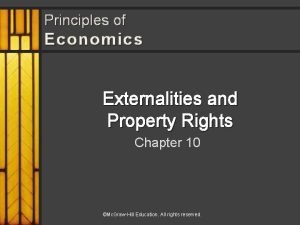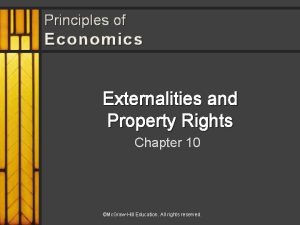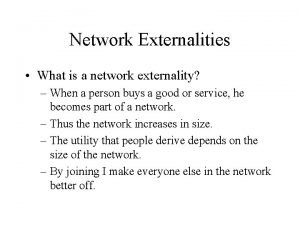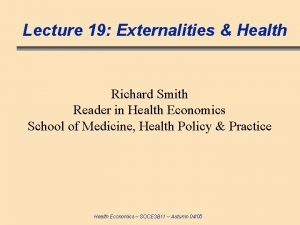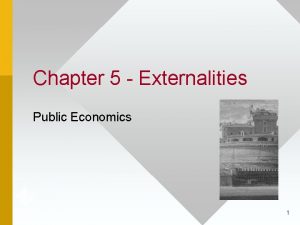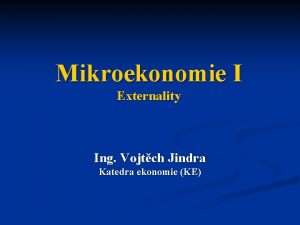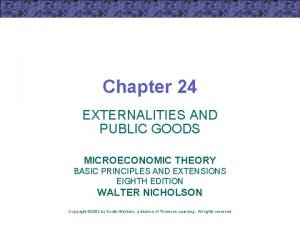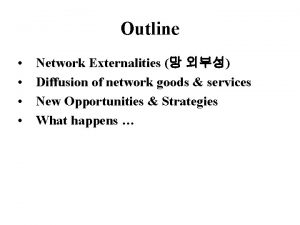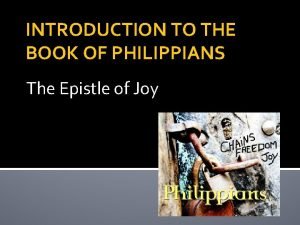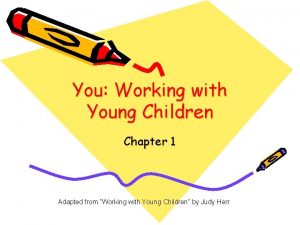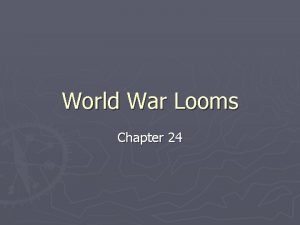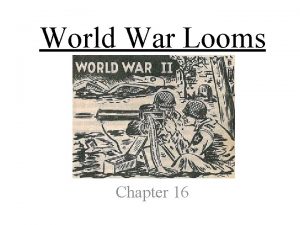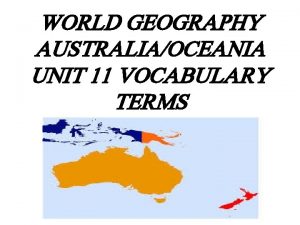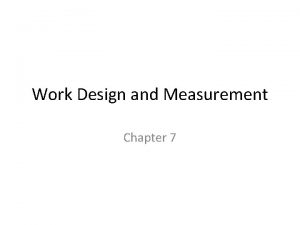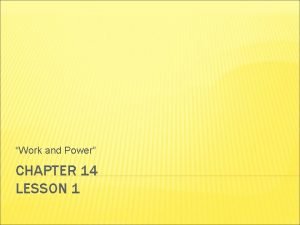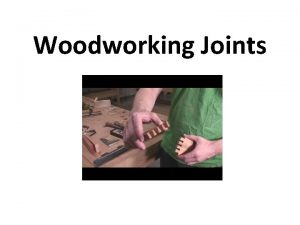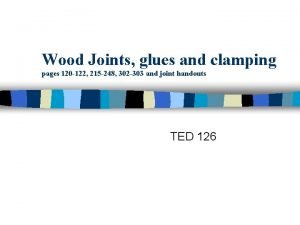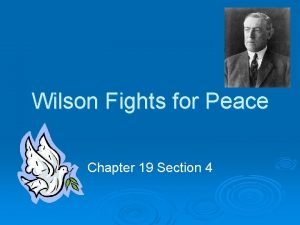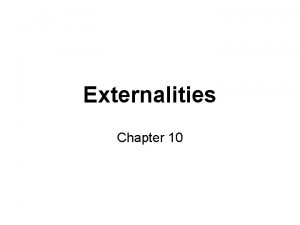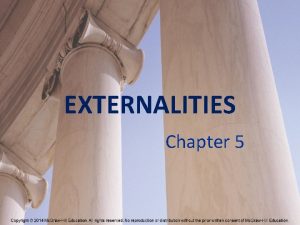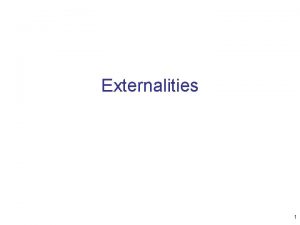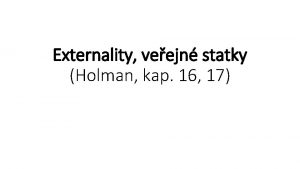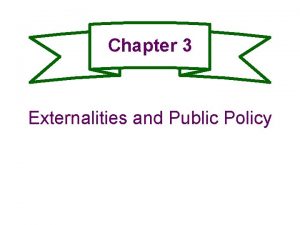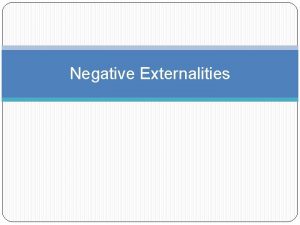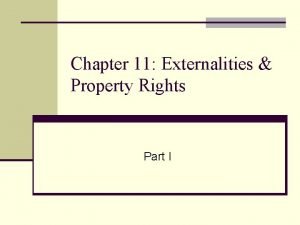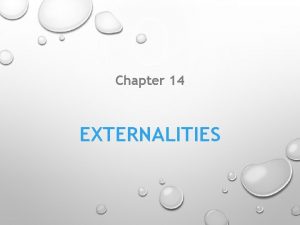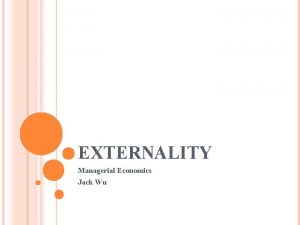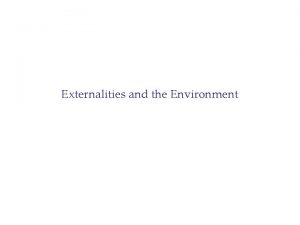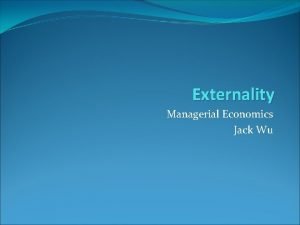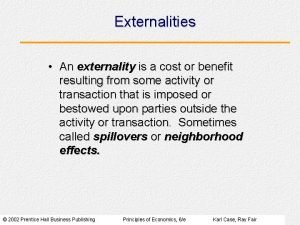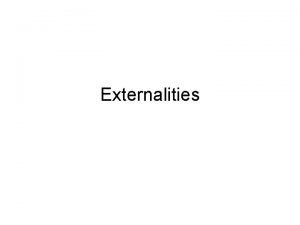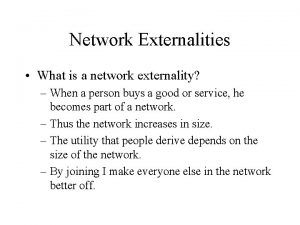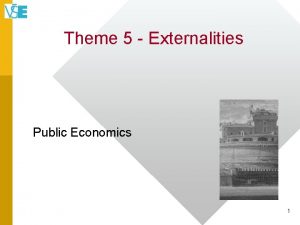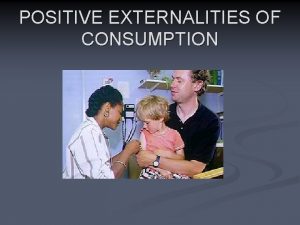Chapter 34 Externalities Externalities An externality is a




























































- Slides: 60

Chapter 34 Externalities

Externalities An externality is a cost or a benefit imposed upon someone by actions taken by others. n A benefit caused by someone else (externally imposed ) is a positive externality. n An externally imposed cost is a negative externality. n

Examples of Negative Externalities n n n Air or water pollution. Loud parties next door (to which you’re not invited). Traffic jams. Passive smoking. Increased insurance premiums because others drink, smoke or drive carelessly. A perfume worn by the person next to you to which you have an allergic reaction.

Examples of Positive Externalities A pleasant perfume worn by the person seated next to you. n Flowers in your neighbour’s garden which look pretty from your window. n Improved driving habits that reduce accident risks. n A shift of travelling from cars to public transport which reduces air pollution. n

Externalities and Efficiency n n The whole argument why competitive markets result in Pareto efficiency presupposes that there are no externalities. Externalities cause Pareto inefficiency; typically ¨ too much scarce resource is allocated to an activity which causes a negative externality ¨ too little resource is allocated to an activity which causes a positive externality.

Inefficiency & Negative Externalities n n Consider two agents, A and B, and two commodities, money and smoke. A is a smoker - both smoke and money are good( thing)s for A. B doesn’t smoke and doesn’t like smoke. Money is a good and smoke is a bad for B. They share a room and therefore breathe same (equally smoke-filled) air.

Agent A is endowed with y. A SEK. n Agent B is endowed with y. B SEK. n Smoke intensity is measured on a scale from 0 (no smoke) to 1 (maximum concentration). n

Smoke Money and smoke are both goods for Agent A. 1 0 OA y. A money. A

Smoke 1 r tte Be 0 OA y. A m. A

Smoke But smoke is a “bad” for B, not a “good”. 0 OB Be tt er 1 y. B Money. B

Turn the diagram for B around to make an Edgeworth Box Smoke 1 r tte Be m. B y. B 0 OB

What are the efficient allocations of smoke and money? Smoke 1 0 OA m. B m. A 0 OB

Efficient allocations of smoke and money. Smoke 1 0 OA 1 Smoke y. A m. A y. B m. B 0 OB

Efficient allocations Smoke 1 0 OA 1 y. A m. A y. B m. B 0 OB

Suppose there is no means by which money can be exchanged for changes in smoke level. n What then is A’s most preferred allocation? n Is this allocation efficient? n

Smoke 1 The choices 1 0 OA A has – income y. A and some amount of smoke y. A m. A y. B m. B 0 OB

A’s most preferred choice is income y. A and as much smoke as possible. This choice is inefficient Smoke 1 0 OA 1 y. A m. A y. B m. B 0 OB Smoke

B’s most preferred choice is income y. B and no smoke. This choice is inefficient too. Smoke 1 0 OA y. A m. A y. B m. B 0 OB

n n n So if A and B cannot trade money for changes in smoke intensity, then the outcome is inefficient. There is no market for smoke-filled or smokefree air because there are no property rights. If property rights are introduced: ¨ Either A can have the right to smoke which is tantamount to giving A ownership of the air in the room. ¨ Or B can have the right to breathe smoke-free air which is tantamount to giving the ownership to B.

Suppose Agent B is assigned ownership of the air in the room. n Agent B can now sell “rights to smoke”. n Will there be any smoking? n If so, how much smoking and what will be the price for this amount of smoke? n Let p*s be the price paid by Agent A to Agent B in order to be allowed to create a smoke intensity of s. n

A line from (y. A, 0) with the slope -p is a budget constraint for A. Smoke 1 Initial endowments 0 OA y. A m. A y. B m. B 0 OB

p*s. A transferred from A to B Smoke 1 s. A 0 OA y. A m. A y. B m. B 0 OB Both agents gain and there is a positive amount of smoking.

Smoke 1 1 s. A 0 OA y. A m. A y. B m. B 0 OB Both agents gain and there is a positive amount of smoking.

Internalising externalities At the smoke level s, A compensates B for the smoke – bears the cost of the external negative effect caused by A’s smoking. n Making a producer of an externality to bear the full external cost or to enjoy the full external benefit is called internalizing the externality. n

Suppose instead that A is assigned the ownership of the air in the room. n B can now pay A to reduce the smoke intensity. n How much smoking will there be? n How much money will B pay A? n

Smoke 1 0 OA 1 y. A m. A y. B m. B 0 OB

Smoke 1 0 OA 1 y. A m. A y. B m. B 0 OB

Smoke p*s. B 1 1 s. B 0 OA y. A m. A y. B m. B 0 OB

Smoke p(s. B) 1 1 s. B 0 OA y. A m. A y. B m. B 0 OB Both agents gain and there is a reduced amount of smoking.

n Notice that the ¨ agent given the property right (asset) is better off than at her own most preferred allocation in the absence of the property right. ¨ amount of smoking that occurs in equilibrium depends upon which agent is assigned the property right. ¨ A general problem in cases like this is that both parties may consider that they should have the property rights.

Smoke p(s. A) p(s. B) 1 1 s. B s. A 0 OA y. A m. A y. B m. B s. A ¹ s. B and the net incomes also depend on who “owns the air” 0 OB

n n n Is there a case in which the same amount of smoking occurs in equilibrium no matter which agent is assigned ownership of the air in the room? If for both agents, preferences are quasilinear in money; U(m, s) = m + f(s), we have seen (exc. 6. 3) that demand for smoke doesn’t depend on income. In this special case, the amount of smoke at the efficient point does not depend on who has the property right.

Coase’s Theorem n Coase’s Theorem is: If all agents’ preferences are quasilinear in money, then the efficient level of the externality generating commodity is produced no matter which agent is assigned the property right.

Production Externalities n n n A chemical factory produces jointly herbicides and pollution. The pollution causes allergies and asthma in children living nearby. The local health clinic treats the children. ph is the market price of herbicides. cx is the medical cost that come from an increase of pollution by one unit. For simplicity we ignore the “intangible costs” of illness – the argument would be analogous if we can attach a value to the loss of well-being.

ch(h, x) is the chemical firm’s cost of producing s units of herbicide jointly with x units of pollution. n If the chemical firm does not face any of the external costs of its pollution production then its profit function is n n and the firm’s problem is to maximise this function.

First-order maximization conditions In other words, production is carried on up to the point where the marginal cost of increasing production of herbicides is equal to the price and where the marginal gain from increasing pollution is zero.

is the rate at which the firm’s internal production cost goes down as the pollution level rises Conversely is the marginal cost to the firm of pollution reduction. The marginal benefit to the firm of pollution production is zero since it does not pay the health care costs.

But the marginal social cost is cx n If the firm had to pay the health care costs it caused it it would only increase production of pollution until n n If we assume that the marginal benefit of increasing pollution is decreasing, this means that a firm that was made responsible for the damage it caused would produce less pollution (and less herbicides). Because the cost of treating allergies is external to the firm, it overproduces. An emissions tax of cx would increase efficiency and welfare.

Production Externalities: A numerical example: A foundry produces steel (s) and pollution (x) Its cost function is: c. S(s, x) = s 2 + (x - 4)2 Assume that p. S = 12 The profit function will be: Π(s, x) = 12 s - s 2 - (x - 4)2 and the first order conditions for maximum are: Π’s(s, x) =12 -2 s = 0 s=6 Π’x(s, x) =2(x-4) = 0 x=4 Π(6, 4) = 72 – 36 – 0 = 36

Downstreams from the foundry is a fishery whose production depends (negatively) on the level of pollution in the water. n The cost to the fishery of catching f units of fish (which it can sell at a price of p. F = 10) when the steel mill emits x units of pollution is c. F(f, x) = f 2 + xf n Given f, c. F(f, x) increases with x; i. e. the steel firm inflicts a negative externality on the fishery. n

n The fishery’s profit function is n and the first order condition Π’F = 10 - 2 f - x = 0 Without any pollution f = 5 and Π = 25 With a pollution of x=4, f = 3 and Π = 9 Thus, production and profits are lower in the presence of pollution. This is the external cost of the pollution. n n

Are these choices by the two firms efficient? n When the steel firm ignores the external costs of its choices, the sum of the two firm’s profits is 36 + 9 = 45. n Is 45 the largest possible total profit that can be achieved? n What happens if the two firms merge? n

Merger and Internalization n Profits of the new firm are. n First order conditions for maximum: 12 -2 s = 0 (1) 10 – 2 f – x = 0 (2) -2(x-4)- f = 0 (3) (1) s = 6 (2) x = 10 – 2 f (4) (3) & (4) -2(10 -2 f-4) = f f = 4; Note that: and n n n n x=2

And the merged firm’s maximum profit level is Without merger, total profits were 45 and pollution was 4. After a merger, profits are 48 and pollution is 2. • The merger has internalised the externality. • Efficiency has increased. • Pollution is decreased.

In the merged firm the profit function is The marginal cost of pollution is The merged firm’s marginal pollution cost is larger because it faces the full cost of its own pollution through increased costs of production in the fishery, so less pollution is produced by the merged firm.

Merger and Internalization How else might internalization be caused so that efficiency can be achieved? n Property rights (create a market) n Taxes n Tradeable emission quotas n Restrictions on production or emissions n

Coase argues that the externality exists because neither the steel firm nor the fishery owns the water being polluted. n Property right to the water can be created and assigned to one of the firms. This would induce efficiency (and benefit whoever got the property rights). n To give the fishery the rights would agree with the Polluter Pays Principle n

Tradeable emissions quotas: The government sets a target for reduction of emissions. n Each firm is given or allowed to buy a certain quantity of emission-rights. n A firm that emits less than its quota can sell the right to emit to somebody else. n Reductions will be made where it is cheapest to make them. n

Taxing pollution n n Assume that the foundry has to pay a tax of t*x where t is a tax rate. If t is set so that at the socially optimal level of x, the MC of polluting to the foundry will be equal to the social MC and it will reduce pollution to the optimal level. In the example, set t = 4 and solve the foundry’s profit maximisation problem! This kind of tax is called a Pigouvian tax. They are good if they are set correctly but to set them correctly requires knowledge of the optimal level of pollution.

The Tragedy of the Commons Consider a grazing area owned “in common” by all members of a village. n Villagers graze cows on the common. n When c cows are grazed, total milk production is f(c), where f’>0 and f”<0. n How should the villagers graze their cows so as to maximize their overall income? n

The Tragedy of the Commons Milk f(c) Slope = f(c)/c= AP cows The marginal and average products decrease when the number of cows increase.

n Assume that: ¨ the price of milk is 10 ¨ the cost of grazing a cow is pc. n The profit function for the entire village is and the village’s problem is to

To maximise the village’s income the number of cows, c*, should be such that f’(c) = pc The marginal product from the last cow grazed must equal the marginal cost of grazing it. But for each villager it pays to buy another cow until the average product is equal to pc If AP is decreasing, MP>AP. So when AP(c) = pc, MP(c) < pc. The common pasture will be overgrazed if: • each villager considers only their own cost and income. • there is no restriction on entry

Will this happen? n n Modern-day “tragedies of the commons” include ¨ over-fishing the oceans ¨ Air pollution, greenhouse gases and congestion from cars. BUT there are other commons where tragedies have been avoided. The conventional economist’s advice is “privatise and introduce markets”. BUT different societies have handled the preservation of common resources also through institutional setups other than private property and markets.

Elinor Ostrom, Nobel laureate 2009 n “Elinor Ostrom has challenged the conventional wisdom that common property is poorly managed and should be either regulated by central authorities or privatized. Based on numerous studies of user-managed fish stocks, pastures, woods, lakes, and groundwater basins, Ostrom concludes that the outcomes are, more often than not, better than predicted by standard theories. She observes that resource users frequently develop sophisticated mechanisms for decision-making and rule enforcement to handle conflicts of interest, and she characterizes the rules that promote success-ful outcomes. ” n (Quoted from the statement to the Public by the Royal Academy of Sciences)

n n n At http: //www. kva. se/en/pressroom/press-releases 2009/The-Prize-in-Economic-Sciences-2009/ you will find two documents. The part about Ostrom in “Information for the public” is included in the course literature. Read it! If you are a bit more interested, also read the other document “Scientific background”.

n Ostrom builds on own and other case studies of governance of Common Pooled Resources ¨ Game-theory and experiments. ¨ n She has studied user-managed ¨ Fish stocks ¨ Pastures ¨ Woods ¨ Lakes ¨ Groundwater basins

n n A CPR is a resource to which more than one individual has access but where each person’s consumption reduces availability of the resource to others. It is not possible to lay down one rule for managing all CPRs. It depends the technological nature of the resource and the institutional context that has evolved over time. Privatisation works in some cases but may not work where it is difficult for users to agree on the terms. (Underground water basins or oil pools). Government intervention may work in some cases, particularly with large scale CPRs but may also ”create more chaos than order” if central government lacks local information or legitimacy.

A third option: Retain the resource as common property and let the users create their own system of governance. n n A lot of cases show local communities succesfully managing CPRs but their are also failures. The kinds behaviour observed in governance of CPRs has also been found in experiments. A key element is sanctions: economic theory has to ask why individuals are willing to undertake costly monitoring and sanctioning. Can’t be explained only by self-interest. ¨ Another central issue is reciprocity. ¨

When does local governance work well? n n n n (i) rules should clearly define who has what entitlement, (ii) adequate conflict resolution mechanisms should be in place (iii) an individual’s duty to maintain the resource should stand in reasonable proportion to the benefits. (iv) monitoring and sanctioning should be carried out either by the users themselves or by someone who is accountable to the users. (v) sanctions should be graduated, mild for a first violation and stricter as violations are repeated. (vi) governance is more successful when decision processes are democratic, in the sense that a majority of users are allowed to participate in the modification of the rules and when (vii) the right of users to self-organize is clearly recognized by outside authorities. vii) In the case of larger common-pool resources: organization in the form of multiple layers of nested enterprises, with small local CPRs at the base level.
 Positive externality deadweight loss
Positive externality deadweight loss Positive externality deadweight loss
Positive externality deadweight loss What are network externalities
What are network externalities Deadweight loss with positive externality
Deadweight loss with positive externality Coase theorem example
Coase theorem example Socially optimal quantity externality
Socially optimal quantity externality Coase theorem
Coase theorem Positive consumption externality
Positive consumption externality Example of negative externality
Example of negative externality Externality examples
Externality examples Tragedy of the commons
Tragedy of the commons Externality
Externality Externalities in environmental economics
Externalities in environmental economics Pure public good
Pure public good Externalities problems and solutions
Externalities problems and solutions Myspace
Myspace The red tent summary
The red tent summary The great gatsby chapter 8 setting
The great gatsby chapter 8 setting Chapter 10 chemical reactions answer key
Chapter 10 chemical reactions answer key Chapter 11 stoichiometry answer key
Chapter 11 stoichiometry answer key Chapter 9 chemical reactions test answers
Chapter 9 chemical reactions test answers Chapter 7 similarity
Chapter 7 similarity Chapter 6 career readiness review
Chapter 6 career readiness review 7 ionic and metallic bonding
7 ionic and metallic bonding Chapter 9 surface water answer key
Chapter 9 surface water answer key Chapter 2 representing motion
Chapter 2 representing motion Chemistry central science 14th edition
Chemistry central science 14th edition Chapter 7 ionic and metallic bonding answer key
Chapter 7 ionic and metallic bonding answer key Section 1 population dynamics answer key
Section 1 population dynamics answer key Chapter 2 chapter assessment
Chapter 2 chapter assessment Facts about the philippian jailer
Facts about the philippian jailer Properties of ionic compounds
Properties of ionic compounds Chapter 7 chapter assessment ionic compounds and metals
Chapter 7 chapter assessment ionic compounds and metals 9 chemical names and formulas
9 chemical names and formulas Zeta phi beta membership intake process
Zeta phi beta membership intake process Working with young children chapter 1
Working with young children chapter 1 Mrs heathcliff
Mrs heathcliff Wuthering heights chapter 6
Wuthering heights chapter 6 Findings of qualitative research
Findings of qualitative research Chapter 24 world war looms
Chapter 24 world war looms Chapter 16 building vocabulary world war looms
Chapter 16 building vocabulary world war looms Chapter 27 world war 1 and the russian revolution
Chapter 27 world war 1 and the russian revolution Lesson 4 world war 1 ends
Lesson 4 world war 1 ends Chapter 17 section 3 world history
Chapter 17 section 3 world history Chapter 32 assessment world history
Chapter 32 assessment world history Chapter 30 section 2 world history
Chapter 30 section 2 world history Chapter 8 nationalist revolutions sweep the west
Chapter 8 nationalist revolutions sweep the west Chapter 15 section 2 world history
Chapter 15 section 2 world history Chapter 10 section 2 central america and the caribbean
Chapter 10 section 2 central america and the caribbean Ap human geography chapter 11 vocab
Ap human geography chapter 11 vocab World geography chapter 3 climates of the earth
World geography chapter 3 climates of the earth Chapter 7 work design and measurement
Chapter 7 work design and measurement Chapter 14 section 1 work and power
Chapter 14 section 1 work and power Woodwork joints names
Woodwork joints names Chapter 9 adhesives gluing and clamping answer key
Chapter 9 adhesives gluing and clamping answer key Chapter 19 section 4 wilson fights for peace
Chapter 19 section 4 wilson fights for peace Why study financial markets?
Why study financial markets? Wnhen
Wnhen Where the red fern grows chapter 10
Where the red fern grows chapter 10 Ap psychology chapter 14
Ap psychology chapter 14 The great gatsby quiz
The great gatsby quiz
